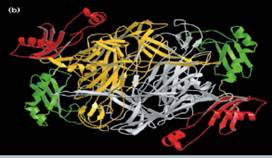Diamine Oxidase for Research Use (DAO)
EC 1.4.3.22 our Product Number: 50-0903-001.
 DAO is an enzyme (EC 1.4.3.22) composed of 642 amino acids. It is a homo-dimer of two identical subunits. Each subunit contains 2 disulfide bounds and a free cysteine with a theoretical molecular weight of 72,878 daltons per unit (a nominal molecular weight of 73 ±3 kDa is used for analytical purposes). DAO active site contains copper (II) and phenylalanine quinone: 2,4,5-trihydroxyphenylalanine quinone (TPQ). The products of the CuAO-catalysed oxidative deamination of amines such as histamine are various aldehydes, ammonia, and hydrogen peroxide. The copper is essential for activity and is believed to play a redox role in substrate turnover (Dooley et al., 1991; Turowski et al., 1993).
DAO is an enzyme (EC 1.4.3.22) composed of 642 amino acids. It is a homo-dimer of two identical subunits. Each subunit contains 2 disulfide bounds and a free cysteine with a theoretical molecular weight of 72,878 daltons per unit (a nominal molecular weight of 73 ±3 kDa is used for analytical purposes). DAO active site contains copper (II) and phenylalanine quinone: 2,4,5-trihydroxyphenylalanine quinone (TPQ). The products of the CuAO-catalysed oxidative deamination of amines such as histamine are various aldehydes, ammonia, and hydrogen peroxide. The copper is essential for activity and is believed to play a redox role in substrate turnover (Dooley et al., 1991; Turowski et al., 1993).
The organic cofactor identified as Topa quinone, which is formed by post-translational modification of an invariant tyrosine residue, serves as the site of substrate binding (Janes et al., 1990; Brown et al., 1991). The formation of the TPQ cofactor occurs via a novel self-processing mechanism in which a tyrosine residue is oxidized by protein-bound copper andoxygen (Cai, D. & Klinman, J.P. 1994 and Matsuzaki, R. et al. 1994).
Plant DAOs (histaminase)
Plant DAOs (histaminase) differs from the mammalian and prokaryotic enzymes in a number of peculiar features, mainly high turnover rate of catalysis, high binding affinity for histamine, and high chemical stability. The native Pisum sativum Diamine Oxidase (EC 1.4.3.22) can also be found in different organisms such as bacteria, yeasts, mushrooms, various plants, and animals. A review article by R. Medda, et al. in 1995 describes in detail research in this area.
Plant DAOs, or Diamine Oxidase enzymes, have several benefits when it comes to human health and the metabolism of histamine. Here are some of the benefits of plant DAOs:
- Histamine Metabolism:
- Histamine Intolerance:
- Allergy Management:
- Gut Health:
- Dietary Flexibility



